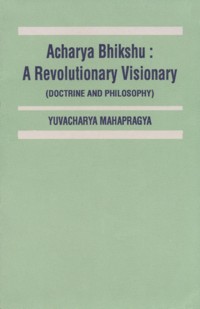Acharya Bhikshu established that nonviolence and compassion are one. His famous dictum is: A sentient being's living is not compassion nor is its dying violence8 killing is violence and not- killing is compassion.[29]
Not-killing is at the same time nonviolence, compassion and granting of freedom from fear (अभय दान). Acharya Hemchandra's exposition of अभय दान resembles that of Acharya Bhikshu:
भवत्यभयदानं तु, जीवानं वधवर्जनम्
मनोषाक्काये: करणकारणनुमतैरपि[30]
छह काय मारण रा त्याग रे, कोई पचखे आण वैराग ए
ए अभयदान कह्यो जिनराय रे, धर्मदान में मिलियो आयए[31]
Mahatma Gandhi's view is also not different from that of Acharya Bhikshu: Nonviolence is absence of animosity towards a sentient being. It begets freedom from fear to any living being howsoever small it may be.[32]
Acharya Bhikshu did independent thinking on compassion (दया) and sympathy अनुकम्पा). He wrote a book: Anukampa ki Choupayi. In this book we come across the spirit of a language philosopher and the use of analytical vibhajyavadi (विभज्यवादी) style.
He said: You consider compassion or kindness as spiritual religion, which is not proper. Compassion has two forms:
- worldly or social
- transcendental or spiritual
Philosophy of language has a branch called "positivism" according to which truth is of two types:
- universal
- individual
In the language of nyaya school the first is generic truth and the other is specific truth. When we say "cow", we mean "all cows". This is generic truth. When we say "white cow" we distinguish between "a white cow" and "a black cow". This is specific truth. The word "man" includes "all men" of the world. This is generic truth. But "tall man", "white man", "black man" belong to specific truth. Generic truth and specific truth should not be identified with each other. Acharya Bhikshu states that we get milk from a cow, a buffalo, आक and थोर (poisonous plants). But आक milk cannot take the place of cow's milk. Cow's milk is nutritious, while milk can cause death. The moment an adjective is used before milk, its specific truth becomes manifest. Cow's milk is easy to digest while buffalo's milk is difficult to digest and increases cholestrol. आक and थोर milk is used for medicinal purposes and cannot be used as food. Similarly, an adjective can be used before compassion: which compassion is worldly and which is transcendental?
In philosophical thinking linguistic analysis is of great importance. Language is a means of communication. Its aim is to transmit one person's thoughts to another. If we fail to use language appropriately, the listener will understand something different from what we actually wanted to convey. The relevance of निक्षेप system lies in the fact that it enables the speaker or the writer to use language in such a way that the listener or the reader gets the same meaning as the speaker or the writer wanted to convey. Acharya Bhikshu has used the निक्षेप system in explaining compassion or kindness. According to निक्षेप system everything has at least four stages or modes. The name of a thing is one of its modes. A thing is given a name which identifies it. Another is स्थापना, a process of knowing a thing with the help of its features, its shape. The third mode is substance. It is an object's past and future state. The fourth mode is भाव It is an object's present state.
There are two aspects of भाव निक्षेप:
- Worldly compassion - compassion accepted by society
- Transcendental compassion - compassion aimed at salvation
In this way kindness (दया), charity (दान), service (सेवा) and religion (धर्म) also have two aspects each:
- Worldly kindness - kindness accepted by society
- Transcendental kindness - kindness aimed at salvation
- Worldly beneficence उपकार - beneficence accepted by society
- Transcendental beneficence - beneficence aimed at liberation
- Worldly charity - charity accepted by society
- Transcendental charity - charity aimed at liberation
- Worldly service - service accepted by society
- Transcendental service - service aimed at liberation
- Worldly religion - religion accepted by society
- Transcendental religion - religion aimed at liberation
Compassion which is motivated by passion and attachment is worldly compassion, while compassion that is devoid of them is transcendental compassion. As a social animal man lives in society, so he acts according to worldly compassion. Acharya Bhikshu did not object to it. What he meant to say was we should not mix one with the other. In order to make his point clear he used the following expressions again and again:
- Ways of the world, path to salvation
- Worldly beneficence, beneficence for salvation
- Worldly duty, duty of liberation
- Worldly kindness, other worldly kindness.
To put it in a nutshell, he said: ज्ञानी हुवे तो न्यारा जाने
An enlightened person does not mix worldly duty with aspiration for salvation; he makes a separate assessment of each one of them. If only Acharya Bhikshu's philosophy of language had been comprehensive! In that case its comprehensiveness would have incorporated solutions to social and sectarian problems.
The awakening of this sense of discrimination is very essential - let social tendencies operate at the social level, and let religion aim at individual spiritual practice. But what happened was that religion was transformed into a social or sectarian entity. The result was that there was neither pure socialism nor pure religiosity. Sprinkling sugar and flour around ant-holes is being considered kindness, while kindness is being ignored while exploiting a person. This is a distorted form of kindness.
The original meaning of kindness is getting rid of cruelty. A kind person cannot be inhuman towards anyone, be he his servant, his official, his neighbour or a foreigner. He cannot get in the way of anybody earning his livelihood. Rather than being kind in this way, people consider feeding ants with flour more important. Therefore, Acharya Bhikshu said again and again: Discriminate. Try to understand the true meaning of a word. Which kindness? Which compassion? Which religion? Don't just get stuck in compassion, kindness and religion as if they were only names.[34] Without understanding the philosophy of language, our understanding of reality cannot be authentic. Those who have tried to explore truth have realised the importance of linguistic analysis. Therefore, before we attempt to understand Acharya Bhikshu's thoughts, it is essential to understand linguistic analysis.
Those who have delved deep in understanding the nature of kindness based on nonviolence are not different from Acharya Bhikshu in the spirit of their thinking. Lord Buddha said: "0 Bhikshu! There are two kinds of compassion - material and religious - the religious compassion being superior."[35]
Mahatma Gandhi has inquired into kindness very minutely. He says: "Kindness towards living beings does not just consist in not killing little insects like ants. We should of course not kill them. But we should also not hurt or offend any human being.
If people say religion lies in saving a bedbug even if it involves killing a man, I doubt it; also if someone says it lies in saving a man even if it involves killing a bedbug, I doubt it. I would like to find a way to come out of both these predicaments. That will be real kindness.[36]
Vandittu is a popular prayer of Jain religious practice. One of its verses says: "I deplore the act of kindness done towards a happy or miserable intemperate person if it is motivated by attachment (राग) or animosity (द्वेष).[37]
मारणवाला नै हिंसा कही, नहीं मारे तो दया गुण खान II
गाय, भेंस, आक, थोर नो, ए च्यारू ई दूध I
तिम अणुकम्पा जाणज्यो, राखे मन में सुधि II
आक दूध पीया थका, जुदा करे जीव काय I
ज्यू सावध अणुकम्पा किया, पाप कर्म बंधाय II
भोले ही मत भुलज्यो, अणुकम्पा रे नाम I
कीज्यो अन्तर पारखां, ज्यू सीझ आतम काम II
दया दया सहू को कहे, ते दया धर्म छे ठीक I
दया ओलख ने पालसी, त्याने मुगत नजीक II
रागेण व दासेण व तं निंदे तं च गरिहामि II
 Yuvacharya Mahaprajna
Yuvacharya Mahaprajna
